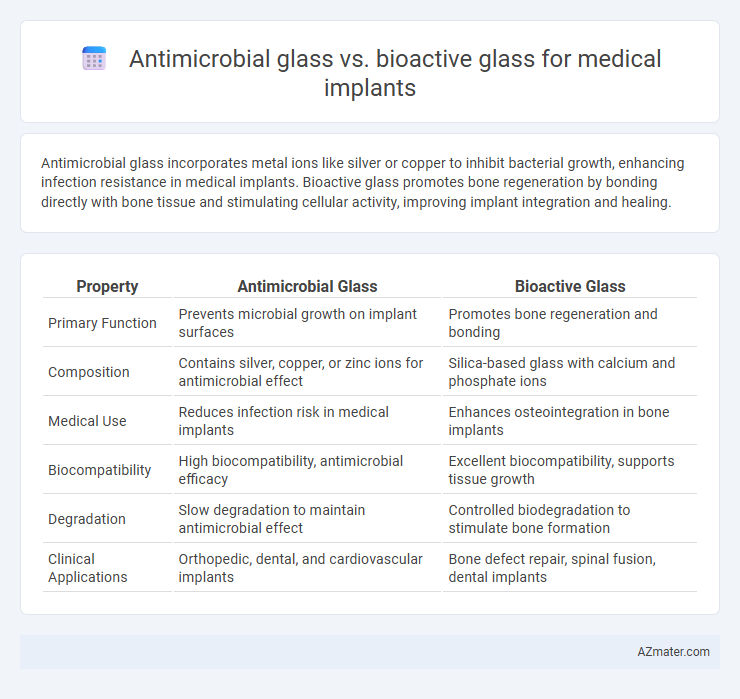Antimicrobial glass incorporates metal ions like silver or copper to inhibit bacterial growth, enhancing infection resistance in medical implants. Bioactive glass promotes bone regeneration by bonding directly with bone tissue and stimulating cellular activity, improving implant integration and healing.
Table of Comparison
| Property | Antimicrobial Glass | Bioactive Glass |
|---|---|---|
| Primary Function | Prevents microbial growth on implant surfaces | Promotes bone regeneration and bonding |
| Composition | Contains silver, copper, or zinc ions for antimicrobial effect | Silica-based glass with calcium and phosphate ions |
| Medical Use | Reduces infection risk in medical implants | Enhances osteointegration in bone implants |
| Biocompatibility | High biocompatibility, antimicrobial efficacy | Excellent biocompatibility, supports tissue growth |
| Degradation | Slow degradation to maintain antimicrobial effect | Controlled biodegradation to stimulate bone formation |
| Clinical Applications | Orthopedic, dental, and cardiovascular implants | Bone defect repair, spinal fusion, dental implants |
Introduction to Antimicrobial and Bioactive Glasses
Antimicrobial glass incorporates metal ions such as silver or copper to inhibit bacterial growth on medical implants, reducing infection risks. Bioactive glass promotes bone regeneration by bonding with surrounding tissues and stimulating cellular responses for enhanced implant integration. Both materials address implant-related complications, with antimicrobial glass targeting infection control and bioactive glass focusing on osteointegration and tissue repair.
Composition Differences: Antimicrobial vs Bioactive Glass
Antimicrobial glass typically incorporates metal ions such as silver, copper, or zinc that inhibit bacterial growth through ion release and surface interaction. Bioactive glass, on the other hand, is primarily composed of silicon dioxide, calcium oxide, sodium oxide, and phosphorus pentoxide, designed to bond with bone and stimulate tissue regeneration through hydroxyapatite layer formation. These compositional differences dictate their primary functions: antimicrobial glasses prevent infection while bioactive glasses promote osteointegration and healing in medical implants.
Mechanisms of Action in Medical Implants
Antimicrobial glass combats infection in medical implants by releasing ions such as silver, copper, or zinc, which disrupt bacterial cell membranes and inhibit biofilm formation. Bioactive glass promotes tissue integration through the formation of a hydroxycarbonate apatite layer that bonds with bone, facilitating osteoconduction and stimulating cellular responses for regeneration. Both glasses enhance implant success by combining antimicrobial properties and bioactivity, but their mechanisms differ: antimicrobial glass targets pathogens directly, while bioactive glass supports biological repair processes.
Infection Prevention: Efficacy Comparison
Antimicrobial glass incorporates metal ions like silver or copper that disrupt bacterial cell membranes, offering rapid and sustained infection prevention on implant surfaces. Bioactive glass promotes tissue regeneration and releases ions such as calcium and phosphate, which create a hostile environment for bacterial colonization but with slower antimicrobial action. Studies show antimicrobial glass provides superior immediate efficacy against a broad spectrum of pathogens, whereas bioactive glass excels in long-term infection management through enhanced osseointegration and biofilm resistance.
Bioactivity and Tissue Integration
Bioactive glass exhibits superior bioactivity compared to antimicrobial glass, promoting rapid hydroxyapatite layer formation that enhances tissue integration and osteointegration in medical implants. This bioactivity facilitates strong bonding between the implant and surrounding bone, accelerating healing and improving implant stability. In contrast, antimicrobial glass primarily focuses on preventing infection through ion release but offers limited enhancement of tissue regeneration and bone bonding.
Longevity and Durability in the Body
Antimicrobial glass exhibits prolonged resistance to microbial colonization, enhancing implant longevity by reducing infection risks and biofilm formation. Bioactive glass supports durable integration with bone tissue through surface reactions that promote hydroxyapatite layer formation, improving mechanical stability over time. While antimicrobial glass primarily targets infection control, bioactive glass ensures structural durability by facilitating tissue bonding and regeneration in medical implants.
Clinical Applications and Use Cases
Antimicrobial glass demonstrates superior efficacy in preventing bacterial colonization on medical implants, reducing infection rates in orthopedic and dental applications. Bioactive glass promotes bone regeneration and osseointegration, making it ideal for bone grafts and implant coatings in maxillofacial and spinal surgeries. Clinical use of antimicrobial glass primarily targets infection control, whereas bioactive glass focuses on tissue repair and integration, offering complementary benefits in implantology.
Safety Profiles and Biocompatibility
Antimicrobial glass incorporates silver or copper ions that inhibit bacterial growth, offering enhanced infection control but presenting potential cytotoxicity risks that require careful concentration management for safe medical implant use. Bioactive glass promotes bone regeneration by bonding directly with surrounding tissue and supporting cellular activities, demonstrating superior biocompatibility and minimal adverse immune reactions in implant applications. Safety profiles favor bioactive glass for long-term implants due to its proven integration with host tissue, while antimicrobial glass demands rigorous evaluation to balance antimicrobial efficacy and biocompatibility.
Current Research and Innovations
Current research in antimicrobial glass for medical implants emphasizes its ability to prevent bacterial colonization through the release of metallic ions like silver, copper, and zinc, enhancing implant longevity and reducing infection rates. Innovations in bioactive glass focus on its capacity to bond with bone tissue by releasing calcium and phosphate ions that stimulate osteogenesis and accelerate healing. Combining antimicrobial properties with bioactivity represents a promising frontier, aiming to create multifunctional implants that simultaneously promote tissue regeneration and prevent infections.
Future Perspectives in Implant Technology
Antimicrobial glass offers significant potential in reducing post-implant infections through sustained release of bactericidal ions, enhancing implant longevity and patient outcomes. Bioactive glass promotes superior osteointegration by stimulating bone regeneration and forming strong bonds with surrounding tissues, positioning it as a key material in next-generation implants. Future implant technology is likely to integrate multifunctional glass composites that combine antimicrobial properties with bioactivity to simultaneously prevent infection and expedite tissue healing.

Infographic: Antimicrobial glass vs Bioactive glass for Medical implant
 azmater.com
azmater.com